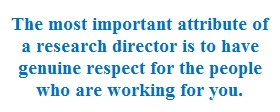Extrinsic vs Intrinsic Motivation
Is it better to motivate employees with money or with a challenging and interesting job?
 A study frequently cited at Harvard Business School on American companies shows that:
A study frequently cited at Harvard Business School on American companies shows that:
-Only 1/3 of employees are motivated to work.
-Only 1/4 of employees trust their bosses.
Establishing and running a company can be done with an individualistic approach. Yet, let's face it, how much can one person achieve on his own? If we really want our companies to grow, expand and last, we need people to help us reach that objective.
To keep employees on the right track, managers must motivate them. The same study cited above also tells us that:
-There is a 127 percent difference in productivity between the best performers and the good performers.
-There is a big difference between the good and the average performers. Where a good performer gets 5 to 10 times more work done, than the average.
Given such a staggering difference between average and top performers, how can we motivate employees to become stars?
Generally speaking, there are two main ways to motivate employees: extrinsic motivation (such as money and other perks) and intrinsic motivation (such as challenging assignments). Our question is: which is the best? Will tangible elements motivate our employees to move forward, or should we challenge them to give their best?
Before we proceed with this question, let's take a step back and look at each motivational path on its own.
 Frederick Hertzberg, a well know American psychologist, said people in the workplace are driven by two sets of factors. The first set, are the hygiene factors, and are needs that keep people from being unhappy. These factors consist of how a person is treated at work, salary, working conditions and security. These factors do not in themselves promote job satisfaction, but serve primarily to prevent job dissatisfaction. The second set is the motivators, which consist of the need to do something, to show what a person is capable of in their best capacity. This includes what a manager lets employees do at work. What do the employees achieve? Do they take responsibility? Are they growing? Are they involved in meaningful and significant work?
Frederick Hertzberg, a well know American psychologist, said people in the workplace are driven by two sets of factors. The first set, are the hygiene factors, and are needs that keep people from being unhappy. These factors consist of how a person is treated at work, salary, working conditions and security. These factors do not in themselves promote job satisfaction, but serve primarily to prevent job dissatisfaction. The second set is the motivators, which consist of the need to do something, to show what a person is capable of in their best capacity. This includes what a manager lets employees do at work. What do the employees achieve? Do they take responsibility? Are they growing? Are they involved in meaningful and significant work?
Extrinsic motivation appears to be an efficient way to obtain what one wants from employees. Employees would do almost anything if their boss threatens them enough or bribes them enough. Extrinsic motivation, whether implemented in a negative or in a positive way, will get people to move. The Lincoln Electric Company is a perfect example of a company that motivates its employees with tangible rewards. Under the Lincoln incentive system, employees are handsomely rewarded for their productivity, high quality cost reduction ideas, and individual contributions to the company. According to a 1947 Harvard Business School case study on the company, the year-end bonuses averaged close to 100 percent of regular compensation, and some workers on the factory floor had earned more than 45,000 USD in a single year. At the time, the median income of U.S. manufacturing employees was less than 9,200 USD.
Intrinsic motivation, on the other hand, refers to behaviour that is driven by internal rewards. In other words, the motivation to engage in certain behaviour arises from within the individual. An employee does a certain task simply because he wants to do that task.
 Is it impossible to imagine a workforce so motivated that employees relish more hours of work, initiate increased responsibility and boast about their challenging work, not their pay checks or bonuses? The answer is: Yes! We can achieve this by understanding the counterintuitive force behind motivation and the ineffectiveness of most performance incentives. Despite media attention to the contrary, motivation does not come from perks, plush offices, or even promotions or pay. These extrinsic incentives may stimulate people to put their noses to the grindstone but they'll likely perform only as long as it takes to get that next raise or promotion.
Is it impossible to imagine a workforce so motivated that employees relish more hours of work, initiate increased responsibility and boast about their challenging work, not their pay checks or bonuses? The answer is: Yes! We can achieve this by understanding the counterintuitive force behind motivation and the ineffectiveness of most performance incentives. Despite media attention to the contrary, motivation does not come from perks, plush offices, or even promotions or pay. These extrinsic incentives may stimulate people to put their noses to the grindstone but they'll likely perform only as long as it takes to get that next raise or promotion.
The truth is organizations have only limited power to motivate employees. Yes unfair salaries may damage morale. But when a company does offer fat pay checks and other extrinsic incentives, people won't necessarily work harder or smarter. In fact, they might become less efficient, especially if they love what they do. In psychology, this is known as the over-justification effect. This occurs when an external incentive decreases a person's intrinsic motivation to perform or participate in an activity. Researchers have found that when extrinsic rewards (such as money and prizes) are given for actions that people already find intrinsically rewarding, they will become less internally motivated to pursue those activities in the future.
A simple example: bribe your child with candy in order to do something he ALREADY enjoys, and you will find that he stops liking it.
If managers and leaders want to bring this internal reward out of our employees, what is the best way to do it? The answer is simple -we should give them the opportunity to use their ability. The key to reaching that objective is to train our employees on a daily basis on everything they need to become the best in their field. A person cannot be motivated if he doesn't know how to do a specific task. But, the more a person can excel in a job, the more they will be motivated to do it. Once an employee is well trained to master a certain skill, managers should challenge them and give them the opportunity to apply what they have learned and to be responsible for what they are doing.
 Jack Rivkin, the man who turned around Lehman Brothers' equity research department, is a perfect example of pushing employees to become intrinsically motivated. Rivkin was very tough to work with, but people were willing to take a cut of a quarter of their salary in exchange for working for him. 20-25 percent of analysts working for him became stars within 3-4 years, while Wall Street's average was 3 percent within 8-12 years. Rivkin believed the most important attribute of a research director is to have genuine respect for the people who are working for you.
Jack Rivkin, the man who turned around Lehman Brothers' equity research department, is a perfect example of pushing employees to become intrinsically motivated. Rivkin was very tough to work with, but people were willing to take a cut of a quarter of their salary in exchange for working for him. 20-25 percent of analysts working for him became stars within 3-4 years, while Wall Street's average was 3 percent within 8-12 years. Rivkin believed the most important attribute of a research director is to have genuine respect for the people who are working for you.
Rivkin made it clear to everybody in the research department that they didn't work for him, he worked for them. If they had problems, he was going to fix them. He also believed that the value of an analyst to an investment bank should come from their industry expertise, not from their stock-picking ability. He used to tell his analysts to become the best industry experts and he would show them how to become successful.
In conclusion, both intrinsic and extrinsic motivation can be used to motivate employees. From a personal experience, I believe that most of us are motivated by intrinsic rewards: Interesting, challenging work, and the opportunity to achieve and grow into greater positions with more responsibility.
Of course, a company has to provide the hygiene factors as mentioned above. But the real key to motivating employees is enabling them to activate their own internal generators.
---END---